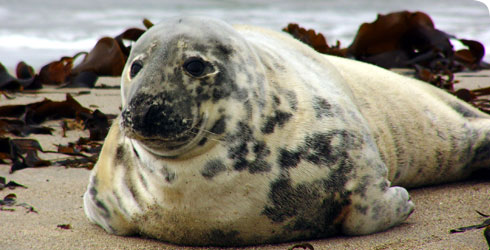Taxonomy
Morphology
Grey seals are large and robust.
The pelage colour and pattern can differ with age, sex and during moulting. Their colouring can range from grey, tan and brown to orange and reddish (on neck, undersides and flippers) (Jefferson et al, 2008). The top of the coat is usually darker than below, and darker, blotchy pigments usually break up the base colour.
Grey seals have an annual moult and prior to this their coats appear paler and duller.
Newborn grey seals are creamy white. They have specialised hair that lasts 2–4 weeks before it is replaced with adult hair that has subtle markings (Jefferson et al, 2008).
The males are larger and have a thicker neck and broader head than the females, with a large muzzle.
It is the distinctive shape of the large, wide muzzle that identifies it from other seal species (Jefferson et al, 2008)
- the species name, grypus, means hook-nosed and refers to the nose profile of the adult male
- Halichoerus means sea pig in Greek (Perrin et al, 2009)
The nostrils are almost parallel to each other and the eyes are small, widely spaced and are further back from the nose than in other seals, because of the large muzzle. (Jefferson et al, 2008)
Phylogeny
There are 2 sub species of grey seal:
- Halichoerus grypus grypus
- Halichoerus grypus macrorhynchus
The Halichoerus grypus grypus populations are from the western and eastern north-Atlantic and Halichoerus grypus macrorhynchus are from the Baltic Sea. The differences between the 2 subspecies are seen in the skull (Jefferson et al, 2008).
Look-alikes
The grey seal is often confused with the habour seal as they can share a single haul out site.
